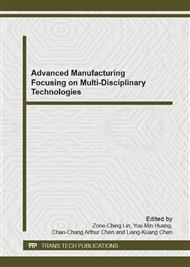p.278
p.287
p.297
p.312
p.330
p.338
p.348
p.357
p.365
Parameters Analysis of Line Segment Fabrication on Near-Field Photolithography
Abstract:
This paper proposes the integral formula of exposure energy density during the movement of work piece to investigate the exposure energy distribution on the photoresist surface. The photoresist was divided into finite nodes to combine the integral formulas of exposure energy density to calculate the relative concentration variation of the photoactive compound (PAC) at each finite node of photoresist interior layer. This paper further combines with Mack’s development model and calculates the average full-width at half maximum (FWHM) of near field photolithography. This study conducted sensitivity analysis to determine how adjusting groups of control parameters influences FWHM and working depth (Hmax). Group A, in which the probe aperture was the adjusted parameter, had the most influence, followed by Group B, in which exposure energy/μm was the adjusted parameter, and Group C, in which development time was the adjusted parameter.
Info:
Periodical:
Pages:
330-337
Citation:
Online since:
October 2012
Authors:
Price:
Сopyright:
© 2012 Trans Tech Publications Ltd. All Rights Reserved
Share:
Citation:


